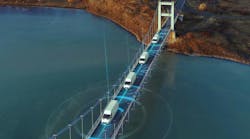Future Sensor Market Growth Will Benefit from New Technology and Applications
Sensors have become an important part of many components and systems, aiding continued growth for the global sensors market. Research firm IDTechEx is projecting the global sensor market will be worth $235 billion by 2035 due to the widespread use of sensors and technological advancements taking place in this space.
In the fluid power sector, for instance, use of sensors has greatly increased in recent years to help enhance performance and collect data. A survey of Power & Motion readers in early 2024 found that 60% of respondents said 21% or more of their system designs include sensors and 16% indicated that 11-20% of their systems include sensors.
Performance monitoring, improved precision and control, and safety were indicated as common uses for sensors in hydraulics and pneumatics.
Use of sensors in these systems, like many others, will continue to rise as automation, electrification and other megatrends shape the future of mobile, industrial and other applications.
Key Drivers for Global Sensor Market Growth
According to IDTechEx’s report “Sensor Market 2025-2035: Technologies, Trends, Players, Forecasts”, trends in future mobility, edge computing, artificial intelligence (AI) and digital healthcare are those having the most influence on sensor technology requirements.
Due to these trends, it foresees photonics, quantum sensing, edge sensing and the Internet of Things (IoT) being the fastest growth sectors within the global sensor market. Semiconductor, optical and conventional transducers – both electromechanical and electrochemical – are among the mature sensor technologies it anticipates accounting for the largest share of the global market in 2025 and beyond.
However, newer sensor technologies will start to gain more market share by 2035.
Autonomous and Electric Vehicles to Increase Need for Various Sensors
Electrification, automation, in-cabin monitoring and software-defined vehicle trends are influencing the design of various vehicle types — from passenger cars all the way up to heavy-duty off-road machinery — and increasing the need for various sensor types. IDTechEx points to the need for temperature, current, voltage and gas sensors in electric vehicles for battery monitoring. As the uptake of electric vehicles continues to rise, so too will the use of these sensors.
Autonomous vehicles employ a wide range of sensors to ensure their safe and accurate operation. Lidar, radar, infrared imaging and camera technology are just a few of those noted by the research firm. These sensors are commonly used to help a vehicle maintain its driving path as well as detect objects, including people, that may be in a vehicle’s path.
For the latter, if an object is detected the sensor will typically send a signal to other vehicle systems, such as the hydraulic brakes, to stop a vehicle, turn away from an object or initiate other evasive maneuvers to prevent safety issues from occurring.
As vehicles become more automated, IDTechEx anticipates additional sensor types will be utilized to enhance the passenger-vehicle interaction from both a safety and experience perspective. Infrared, time-of-flight (ToF), and radar sensors are those it sees being used for in-cabin monitoring as part of advanced driver assistance systems (ADAS) to ensure drivers are staying focused on the road.
More features to keep drivers engaged and passengers entertained are expected as vehicles become more software defined. These too will require the use of various sensors, benefiting the global sensor market in the coming years.
Read more about software-defined vehicles in the below articles.
IoT Remains an Opportunity Area for Sensors
IoT sensors are another opportunity area IDTechEx sees for the global sensor market. Despite the slower adoption and rollout of these sensors, it said their use in industrial, environmental and consumer applications will benefit their continued market uptake.
IoT Analytics — a market insights company focused on IoT, AI, Cloud, Edge and Industry 4.0 — noted the growth in recent years of connected IoT devices in its State of IoT Summer 2024 report. It said the number of connected devices grew 15% in 2023 and 13% growth is anticipated in 2024.
Growth in 2024 is forecast to be lower because many businesses have been more cautious of their spending due to high interest rates and inflation; chipset supply constraints have also been a factor. But in general, IoT Analytics is forecasting the number of connected IoT devices to continue rising in the coming years.
The heavy-duty off-highway equipment market is one of the sectors which has increased its implementation of IoT in recent years. In discussions Power & Motion’s had with IoT providers, several have noted the increased interest from this sector in recent years to implement IoT solutions. The COVID-19 pandemic was an impetus for this as there was a need to access machine performance data remotely.
And with the lack of skilled labor entering the heavy machinery sector, the ability to easily access performance information to aid maintenance and other operational aspects will become increasingly important — and thus likely help drive further implementation of IoT and the sensors which power it.
According to IDTechEx, there are a number of emerging applications that will help drive use of IIoT (Industrial Internet of Things) sensor technology in the coming years as well, including:
- logistics
- worker safety
- inventory management
- industrial robotics and automation
- machine health monitoring and predictive maintenance.
Use of sensors for these applications will aid efforts in the industrial sector to improve efficiency, safety, productivity and operating costs by enabling the collection and analysis of data from an operation.
Although IDTechEx sees IoT as an opportunity area for the sensors market, it does note that the longer return on investment (ROI) associated with these solutions is among the challenges facing this sector. There are high initial capital investments required when implementing an IoT solution as well as operational downtime and difficulties related to legacy infrastructure integration that can be a barrier to the technology’s adoption which could influence growth rates for IoT sensors in the coming years.
Technological Developments to Benefit Continued Sensor Uptake
Continued technological advancements will aid growth for the sensor market in the coming years as well and will be necessary to help meet ever evolving requirements in mobility, industrial automation, 6G and other applications.
Per IDTechEx, emerging sensor technologies will need to offer some of the following qualities:
- be smaller in size,
- require less power,
- offer greater sensitivity and accuracy,
- be integrated into new form factors, and
- measure more metrics and for a longer period of time.
Sensors capable of measuring more than one parameter are already finding their way into the fluid power industry. The Gefran Twiist is one such example from Gefran Inc. This linear position transducer is capable of providing multiple measurements in a single unit including position, temperature, velocity and others in both mobile and industrial hydraulic applications.
A desire for more compact and simplified designs is a key driver for the development of such technologies. Hydraulic systems themselves are becoming more compact as available space within a machine dwindles due to more technologies being integrated into them. Offering a simplified sensor design also helps to reduce installation time while also reducing the total number of sensors required for a system.
Advancements in sensor hardware technology will play an important part in enabling the capabilities required of various applications in the future noted IDTechEx in its report. This is likely to include the use of new materials to help bring new form factors as well as cost savings to the sensors market.
The research firm sees developments in quantum sensor technology increasing and bringing potential cost savings and higher sensitivity capabilities to future sensor designs.
Another area in which it sees developments taking place is integration of edge computing within sensors. IDTechEx said this will enable lower latency smart functionality and reduced energy consumption while also helping to address data privacy concerns.
Edge computing enables data to be processed near a device or on a local server; because this is done at or near where the data is collected, processing can be done quickly and efficiently. As such, it helps larger amounts of data to be processed and reduces delays in doing so which can be vital to safety or other time-critical applications.
IDTechEx said edge sensors are also being co-developed with AI capability to further enhance their intelligence. Per the research firm, this will enable predictive and prescriptive functionality for improved automation of devices in a range of applications.
Overall, there are a range of technological and application opportunities for the global sensors market in the coming years that will aid its continued growth.
About the Author
Sara Jensen
Executive Editor, Power & Motion
Sara Jensen is executive editor of Power & Motion, directing expanded coverage into the modern fluid power space, as well as mechatronic and smart technologies. She has over 15 years of publishing experience. Prior to Power & Motion she spent 11 years with a trade publication for engineers of heavy-duty equipment, the last 3 of which were as the editor and brand lead. Over the course of her time in the B2B industry, Sara has gained an extensive knowledge of various heavy-duty equipment industries — including construction, agriculture, mining and on-road trucks —along with the systems and market trends which impact them such as fluid power and electronic motion control technologies.
You can follow Sara and Power & Motion via the following social media handles:
X (formerly Twitter): @TechnlgyEditor and @PowerMotionTech
LinkedIn: @SaraJensen and @Power&Motion
Facebook: @PowerMotionTech







